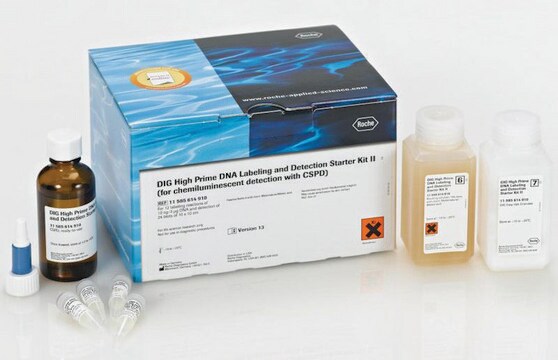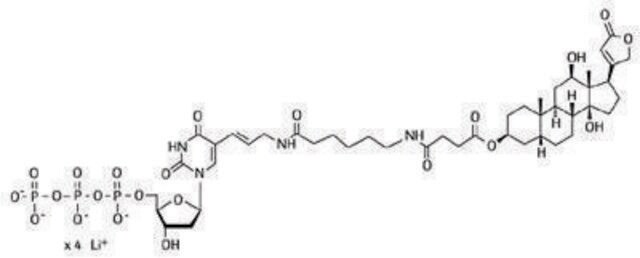11636090910
Roche
PCR DIG Probe Synthesis Kit
sufficient for 25 reaction (50 μL final reaction volume)
Synonym(s):
DIG system, probe
Sign Into View Organizational & Contract Pricing
All Photos(1)
About This Item
UNSPSC Code:
41105500
Recommended Products
usage
sufficient for 25 reaction (50 μL final reaction volume)
Quality Level
manufacturer/tradename
Roche
technique(s)
PCR: suitable
storage temp.
−20°C
General description
The PCR DIG Probe Synthesis Kit contains an alkali-labile digoxigenin (DIG)-11deoxyuridinetriphosphate (dUTP) formulation. This kit is for convenient and efficient generation of DIG-labeled DNA probes that are highly sensitive in polymerase chain reaction (PCR). The probes are labeled with DIG-11dUTP (alkali-labile), by the method of PCR. The ratio of DIG-dUTP:dTTP is 1:2.
The PCR DIG Probe Synthesis Kit contains the Expand High Fidelity DNA polymerase mix. This robust enzyme mix with proofreading activity will polymerize probes 40 bp to 5 kb long using 10 pg plasmid DNA and 10 ng genomic DNA as template. The DIG-labeled probes are stable for over one year.
The PCR DIG Probe Synthesis Kit contains the Expand High Fidelity DNA polymerase mix. This robust enzyme mix with proofreading activity will polymerize probes 40 bp to 5 kb long using 10 pg plasmid DNA and 10 ng genomic DNA as template. The DIG-labeled probes are stable for over one year.
Application
Digoxigenin (DIG)-labeled DNA probes produced from the PCR DIG Probe Synthesis Kit is suitable for low-(single)-copy gene detection of rare mRNA in Southern and northern blots. DIG-labeled DNA probes have also been used for labeling of DNA during in situ hybridization.
The concentration of the supplied dUTP-nucleotide mix can be adjusted according to probe length. Labeling effectiveness can quickly be determined on an agarose gel.
Stripping and reprobing of membranes is possible multiple times following the protocol in the package insert.
One PCR labeling reaction (50 μl) will typically yield enough probe for 20 ml hybridization solution. The kit can be used for approximately 25 reactions (50 μl).
The concentration of the supplied dUTP-nucleotide mix can be adjusted according to probe length. Labeling effectiveness can quickly be determined on an agarose gel.
Stripping and reprobing of membranes is possible multiple times following the protocol in the package insert.
One PCR labeling reaction (50 μl) will typically yield enough probe for 20 ml hybridization solution. The kit can be used for approximately 25 reactions (50 μl).
Packaging
1 kit containing 6 components.
Quality
Each lot of the PCR DIG Probe Synthesis Kit is function tested in PCR. Amplification products are assayed in genomic Southern blots.
Under PCR conditions as described in this package insert, the control reaction generates an amplification product of 442bp. Due to multiple incorporations of DIG-dUTP during the PCR process, the molecular weight of the PCR products is significantly increased compared to the unlabeled PCR product. A specific fragment pattern is detected after hybridization of the PCR product to 10μg human genomic DNA followed by chemiluminescent detection.
Under PCR conditions as described in this package insert, the control reaction generates an amplification product of 442bp. Due to multiple incorporations of DIG-dUTP during the PCR process, the molecular weight of the PCR products is significantly increased compared to the unlabeled PCR product. A specific fragment pattern is detected after hybridization of the PCR product to 10μg human genomic DNA followed by chemiluminescent detection.
Kit Components Only
Product No.
Description
- Enzyme Mix, Expand High Fidelity 3.5 U/μl
- PCR DIG Probe Synthesis Mix, containing dATP, dCTP, dGTP (2 mM each) 10x concentrated
- PCR Buffer with MgCl2 10x concentrated
- dNTP Stock Solution, containing dATP, dCTP, dGTP, dTTP (2 mM each), pH 7.0 10x concentrated
- Control Template, plasmid DNA in Tris/EDTA buffer, pH 8.0. The 5-kb plasmid contains the cDNA for the human tissue-type plasminogen activator (tPA) 20 pg/μl
- Control PCR Primer Mix, containing 50 pmol of each primer, control PCR primer 1 and 2 2 mM each
also commonly purchased with this product
Product No.
Description
Pricing
hcodes
pcodes
Hazard Classifications
Aquatic Chronic 3
Storage Class
12 - Non Combustible Liquids
wgk_germany
WGK 2
flash_point_f
does not flash
flash_point_c
does not flash
Choose from one of the most recent versions:
Already Own This Product?
Find documentation for the products that you have recently purchased in the Document Library.
Customers Also Viewed
Jose Arturo Gutierrez-Triana et al.
eLife, 7 (2018-08-30)
CRISPR/Cas9 efficiently induces targeted mutations via non-homologous-end-joining but for genome editing, precise, homology-directed repair (HDR) of endogenous DNA stretches is a prerequisite. To favor HDR, many approaches interfere with the repair machinery or manipulate Cas9 itself. Using Medaka we show
Chien-Yuan Lin et al.
Plant methods, 13, 113-113 (2017-12-23)
Switchgrass (Panicum virgatum), a robust perennial C4-type grass, has been evaluated and designated as a model bioenergy crop by the U.S. DOE and USDA. Conventional breeding of switchgrass biomass is difficult because it displays self-incompatible hindrance. Therefore, direct genetic modifications
Claudia Sigl et al.
Applied and environmental microbiology, 77(3), 972-982 (2010-12-15)
In filamentous fungi, secondary metabolism is often linked with developmental processes such as conidiation. In this study we analyzed the link between secondary metabolism and conidiation in the main industrial producer of the β-lactam antibiotic penicillin, the ascomycete Penicillium chrysogenum.
Takato Sugiyama et al.
Cell reports, 26(12), 3400-3415 (2019-03-21)
18S non-functional rRNA decay (NRD) eliminates non-functional 18S rRNA with deleterious mutations in the decoding center. Dissociation of the non-functional 80S ribosome into 40S and 60S subunits is a prerequisite step for degradation of the non-functional 18S rRNA. However, the mechanisms
N Toplu et al.
Veterinary pathology, 48(3), 576-583 (2010-05-13)
The present study describes the pathologic changes and cellular apoptosis in the central nervous system (CNS) of fetal and neonatal small ruminants infected with border disease virus (BDV), as demonstrated by immunohistochemistry and in situ hybridization. Abortions of ewes and
Articles
Digoxigenin (DIG) labeling methods and kits for DNA and RNA DIG probes, random primed DNA labeling, nick translation labeling, 5’ and 3’ oligonucleotide end-labeling.
Our team of scientists has experience in all areas of research including Life Science, Material Science, Chemical Synthesis, Chromatography, Analytical and many others.
Contact Technical Service






